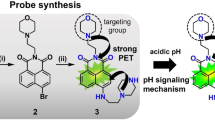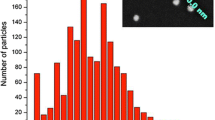Abstract
Encapsulation of fluorophores in silica matrix offers many advantages such inhibition of photobleaching and possibilities for ratiometric pH sensing. Dualfluorophore pH-responsive silica microspheres, incorporating pyranine (HPTS) and rhodamine B isothiocyanate (RBITC), were synthesized by Stöber method, followed layer-by-layer depositions. The resulting dual-fluorophore silica microspheres were then characterized by SEM, TEM, fluorescence spectroscopy and imaging. The incorporation of two dyes in the microspheres allowed ratiometric quantification of pH. The ratiometric approach has been proven to reduce the influences of external perturbations and unequal dye concentration in silica matrix during measurements. The dynamic range for pH was from 1.5 to 4. The sensing microspheres could be applied to determine acidic pH. Additionally, the sensing microspheres exhibited a high colloidal and long-term stability and also allow a fast detection of pH due the porosity of the microspheres. Such structured microspheres could be optimized, using multiple dyes for multianalyte detection.

Similar content being viewed by others
References
J. Han and K. Burgess, Chem. Rev., 24, 297 (2010).
G. Hidalgo, A. Burns, E. Herz, A. G. Hay, P. L. Houston, and U. Wiesner, Appl. Environ. Microbiol., 75, 7426 (2009).
Z. Gryczynski, I. Gryczynski, and J. R. Lakowicz, J. Biophotonics, 360, 44 (2003).
A. Burns, P. Sengupta, T. Zedayko, B. Baird, and U. Wiesner, Small, 2, 723 (2006).
Z. Zhujun and W. R. Seitz, Anal. Chim. Acta, 160, 47 (1984).
Z.-Z. Li, C.-G. Niu, G.-M. Zeng, Y.-G. Liu, P.-F. Gao, and G.-H. Huang, Sens. Actuators, B, 114, 308 (2006).
S.-L. Shen, X.-F. Zhang, S.-Y. Bai, J.-Y. Miao, and B.-X. Zhao, RSC Adv., 5, 13341 (2015).
H. Offenbacher, O. S. Wolfbeis, and E. Fürlinger, Sens. Actuators, 9, 73 (1986).
R. N. Dansby-Sparks, J. Jin, S. J. Mechery, U. Sampathkumaran, T. W. Owen, B. D. Yu, K. Goswami, K. Hong, J. Grant, and Z.-L Xue, Anal. Chem., 82, 593 (2009).
A. J. Amali, N. H. Awwad, R. K. Rana, and D. Patra, Anal. Chim. Acta, 708, 75, (2011).
J. R. Lakowicz, Principles of Fluorescence Spectroscopy, 3rd ed., Springer Science+Business Media, New York, 2006.
H. Ow, D. R. Larson, M. Srivastava, B. A. Baird, W. W. Webb, and U. Wiesner, Nano Lett., 5, 113 (2005).
I. Y. Kim, E. Joachim, H. Choi, and K. Kim, Nanomedicine, 11, 1407 (2015).
A. Mills, Q. Chang, and N. McMurray, Anal. Chem., 64, 1383 (1992).
F. J. Arriagada and K. Osseo-Asare, J. Colloid Interface Sci., 211, 210, (1999).
F. Gao, X. Chen, Q. Ye, Z. Yao, X. Guo, and L. Wang, Microchim. Acta, 172, 327 (2011).
H. Giesche, J. Eur. Ceram. Soc., 14, 205 (1994).
J. Liang, Z. Lu, J. Xu, J. Li, H. Zhang, and W. Yang, J. Mater. Chem., 21, 1147 (2011).
E. Herz, H. Ow, D. Bonner, A. Burns, and U. Wiesner, J. Mater. Chem., 19, 6341 (2009).
R. N. Smith, L. Reven, and C. J. Barrett, Macromolecules, 36, 1876 (2003).
J.-F. Liu, G. Min, and W. A. Ducker, Langmuir, 17, 4895 (2001).
F. Caruso and H. Möhwald, Langmuir, 15, 8276 (1999).
D. J. Tobler, S. Shaw, and L. G. Benning, Geochim. Cosmochim. Acta, 73, 5377 (2009).
Z. H. Bai, R. Chen, P. Si, Y. J. Huang, H. D. Sun, and D. H. Kim, ACS Appl. Mater. Interfaces, 5, 5856 (2013).
S. H. Lee, J. Kumar, and S. K. Tripathy, Langmuir, 16, 10482 (2000).
Z. Sharrett, S. Gamsey, L. Hirayama, B. Vilozny, J. T. Suri, R. A. Wessling, and B. Singaram, Org. Biomol. Chem., 7, 1461 (2009).
R. V. Benjaminsen, H. H. Sun, J. R. Henriksen, N. M. Christensen, K. Almdal, and T. L. Andresen, ACS Nano, 5, 5864 (2011).
J. Y. Han and K. Burgess, Chem. Rev., 110, 2709 (2010).
S. G. Schulman, S. Chen, F. Bai, M. J. Leiner, L. Weis, and O. S. Wolfbeis, Anal. Chim. Acta, 304, 165 (1995).
R. V. Benjaminsen, H. Sun, J. R. Henriksen, N. M. Christensen, K. Almdal, and T. L. Andresen, ACS Nano, 5, 5864 (2011).
T. A. Krulwich, G. Sachs, and E. Padan, Nat. Rev. Microbiol., 9, 330 (2011).
S. Park, G. S. Lee, C. Cui, and D. J. Ahn, Macromol. Res., 24, 380 (2016).
H. Lee, S. H. Hong, and D. J. Ahn, Macromol. Res., 23, 124 (2015).
Y. S. Chung, M. Y. Jeon, and C. K. Kim, Macromol. Res., 17, 37 (2009).
S. T. Ha, O. O. Park, and S. H. Im, Macromol. Res., 18, 321 (2010).
Author information
Authors and Affiliations
Corresponding author
Additional information
Acknowledgments: This work was supported by the National Research Foundation of Korea (NRF, 2017R1A2B3006770, 2015M3C1A3002152), KU-KIST Graduate School of Converging Science and Technology and a Korea University Grant.
Rights and permissions
About this article
Cite this article
Acquah, I., Roh, J. & Ahn, D.J. Dual-fluorophore silica microspheres for ratiometric acidic pH sensing. Macromol. Res. 25, 950–955 (2017). https://doi.org/10.1007/s13233-017-5117-6
Received:
Revised:
Accepted:
Published:
Issue Date:
DOI: https://doi.org/10.1007/s13233-017-5117-6




